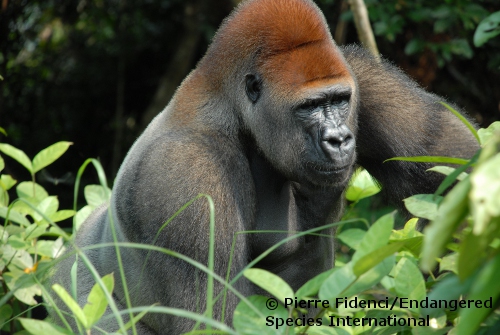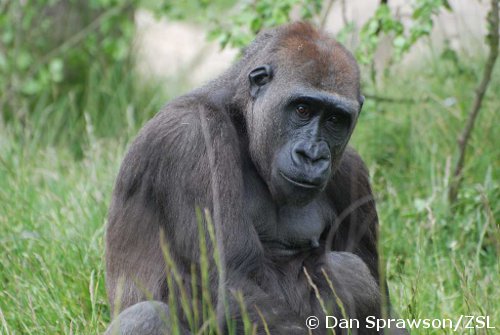
The gorilla is one of the most impressive primates and the largest of the living apes: in some species males can weigh up to 140kg! With an EDGE rank of 69, Western gorillas (Gorilla gorilla) are members of the Hominidae family, which also contains humans, chimpanzees and orang-utans. Until recently it was thought that there was a single species of gorilla with three subspecies; the western lowland, the eastern lowland and mountain gorillas (Gorilla beringei beringei), but DNA analysis showed more genetic differences between eastern and western populations rather than lowland and mountain gorillas. Now the western gorilla has been split into two recognized subspecies: Gorilla gorilla gorilla (western lowland gorillas) and Gorilla gorilla diehli (Cross River gorillas). All males acquire a silver-gray colour across the back and upper thighs at sexual maturity, hence the name ‘silverback’.

From a distance it is hard to distinguish Cross River gorillas from other western gorillas, but on closer inspection they have different skull shapes, especially in the males of the species. They regularly eat leaves, shoots and fruit depending on availability. Like other subspecies the western lowland gorilla spends most of its time on the ground but will climb trees to get fruits and build a nest out of vegetation to sleep in.
Gorillas live in groups averaging 10 individuals, with at least one adult male, several adult females and offspring. Each group’s home range may be as large as 20 km² and a lot of the time group ranges overlap. Unfortunately western lowland gorillas reproduce a lot more slowly, because pregnancies last around 9 months and there is a 4-6 year interval between babies. In addition, infant mortality is higher than that of mountain gorillas.
Western lowland gorillas are found in lowland tropical and swamp forest, particularly where there is dense undergrowth, while Cross River gorillas are restricted mostly to hilly areas. Western gorillas have a wide habitat range across Cameroon, Central African Republic, mainland Equatorial Guinea, Gabon, Nigeria, Republic of Congo, Angola, and possibly in the Democratic Republic of Congo.
In 2007, the Wildlife Conservation Society discovered a new population of 125,000 western lowland gorillas living in the northern area of the Republic of Congo, and intensive surveys over the last decade have found that approximately 250 to 300 Cross River gorillas persist in a forested area of roughly 8,000 km². The total western lowland gorilla population is estimated to be around 100,000 to 200,000 individuals, but data collection is so difficult because they inhabit some of Africa’s densest and most remote rainforests.

Commercial hunting and the Ebola virus are two major threats to the western gorillas. Their very low reproduction means that even low levels of hunting as bush-meat are enough to cause population decline, and a third of the total population in protected areas was wiped out by Ebola during 1992-2007. If the virus continues to spread, it could reach most of the remaining western lowland gorillas within 5-10 years. Climate change may also increase forest fires, which would be lethal to gorillas as well as other wildlife. Cross River gorillas are at risk from inbreeding due to their very small and fragmented population, and a lot of their habitat is being converted for agriculture. As is common in third world countries, enforcement of wildlife laws is often lax, and there are high levels of poorly-controlled poaching, even though killing gorillas is prohibited.
Visit the western gorillas at London Zoo and support ZSL’s conservation projects for these amazing creatures…